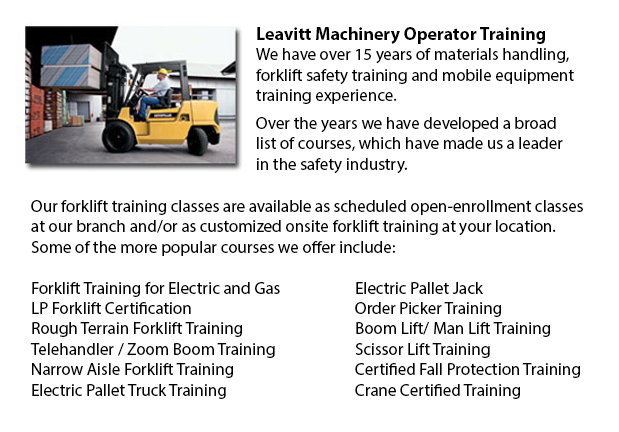
Forklift Training Schools Glendale - Reasons Why Forklift Training Schools Are Vital To Your Company
Are you searching for work as a forklift driver? Our regulatory-compliant mobile equipment operator training offers instruction in types of forklifts, pre-shift inspection, fuel kinds and dealing with fuels, and safe use of a lift truck. Hands-on, practical training helps people participating in obtaining fundamental operational skills. Course content consists of current regulations governing the use of lift trucks. Our proven forklift courses are designed to provide training on these types of trucks: narrow isle forklift, counterbalanced forklift and powered pallet truck.
Whilst the forklift is in operation, do not raise or lower the forks. Loads must not extend over the backrest. This is due to the possibility of the load sliding back in the direction of the operator. Inspect for overhead obstacles and make sure there is sufficient clearance prior to raising a load. Stay away from overhead power lines. Once the load is lifted straight up, tilt it slightly back.
While the load is raised the forklift would be less steady. Make certain that no pedestrians cross beneath the elevated fork. The operator must not leave the forklift while the load is raised.
The forks must be level when handling pallets, and high enough to extend all the way into and underneath the load. The width of the forks must provide even distribution of weight.
Before unloading or loading the truck, set the brakes and chock the wheels. Floors have to be strong enough to support the weight of the load and the forklift combined. Fixed jacks could be installed to support a semi-trailer which is not coupled to a tractor. The entrance door height should clear the forklift height by at least 5 cm. Mark edges of rail cars, ramps or docks and avoid them.
-
Aerial Lift Train the Trainer Glendale
Aerial Lift Train the Trainer Glendale - The Aerial Lifts Train the Trainer Certification Program will teach trainers how to effectively train operators in safe industrial mobile machine operation. Trainers are given in-depth instruction on aerial li... More -
Forklift License Glendale
Forklift License Glendale - In North America, acquiring a forklift license or forklift certification involves hands-on and classroom training. Regulatory control over certification, training and license for powered industrial truck operators falls un... More -
Telehandler Certification Glendale
Telehandler Certification Glendale - Telehandler certification programs are both for operators who have some experience driving a typical forklift and for individuals with no experience. The real-world training provided by these courses produces grad... More -
Operator Safety Training and Re-Qualification Training and In-House Instructor Training in Glendale
Forklifts are used in almost all warehouse operations and in boat yards and in industrial construction sites. The reach feature of a forklift is a very important component utilized in a variety of applications like for example when a shelving system... More -
Manlift Training Glendale
Manlift Training Glendale - Different manlift training programs include the content and review of manlift devices. An important portion of the program is the practicum where students show their practical ability and knowledge to safely operate a manl... More -
Crane Certification Glendale
Crane Certification Glendale - The Crane Certification Program consists of the industry suggested subject matter which will teach the safe and efficient operation of cranes. The individual would train in the following: how to identify cranes and thei... More -
Loader Ticket Glendale
Loader Ticket Glendale - Gehl articulated loaders have been made to suit practically every condition. They offer optimal maneuverability and great traction due to a heavy-duty oscillating joint that provides 45-degree rotating angles right and left,... More -
Crane Ticket Glendale
Crane Ticket Glendale - The new version of a crane could be either simple or complex, and cranes vary based on their use. Mobile cranes, for instance are rather simple. A telescopic boom or steel truss mounts its movable platform. A system of levers... More

Forklift Training Glendale
TOLL FREE: 1-888-254-6157
Glendale, Arizona
forkliftcertificationglendale.com
Email Us
About Us


